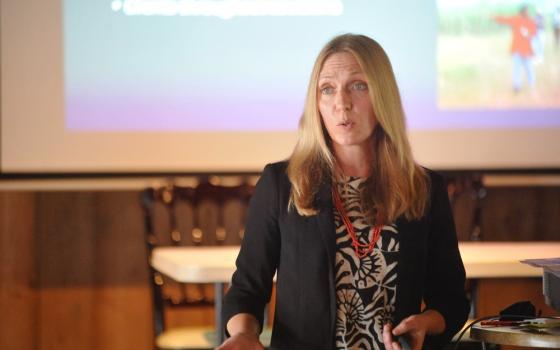Worship & Liturgy
New books offer inspiration, practical tips for faith communities
Since its founding in 1926, the Liturgical Press in Collegeville, Minn., owned and operated by the monks of St. John’s Abbey, has supplied the American church with a broad range of books, pamphlets, periodicals and media resources to support its theological, pastoral and liturgical needs. Fr. Virgil Michel, the indefatigable leader of the Pastoral Liturgical Movement in the United States until his death in 1938, started the press to publish the influential journal Orate Fratres (later named Worship) to foster a nationwide conversation about the need for liturgical renewal. His contributions, and the plethora of pamphlets and books that poured from the Liturgical Press into Catholic parishes and schools, helped set the stage for the Second Vatican Council (1962-65).
Here are four examples taken from the scores of recent titles that continue to provide support for teachers, pastors, liturgical directors, musicians and readers seeking formation and inspiration.
THE GENIUS OF THE ROMAN RITE: ON THE RECEPTION AND IMPLEMENTATION OF THE NEW MISSAL
By Keith F. Pecklers
Published by Liturgical Press, $19.95
As implementation of the new English translation of the Roman Missal gets closer, many churchgoers may still have questions about what the changes are and why this is taking place now. Jesuit Fr. Keith Pecklers’ new book, The Genius of the Roman Rite: On the Reception and Implementation of the New Missal, is useful to both experts responsible for preparing parishes for the new translation and to ordinary readers who want to know the larger historical context for what is an ongoing and necessary process that preserves the doctrinal accuracy of sacred texts while keeping them relevant and proclaimable as public worship.
Pecklers, a professor of liturgy at the Pontifical Gregorian University and professor of liturgical history at the Pontifical Liturgical Institute in Rome, offers an overview of how the texts and rites we use at Sunday Mass emerged in the early church and evolved through successive eras as cultural influences and theological development that shaped the way the church expresses its faith in worship. It is a long and complex history, and controversy has always been a part of the dynamic tension between orthodoxy and adaptation, between conservative and progressive forces struggling over change and the status quo.
Catholic worship as we know it today is the result of the gradual selection and integration of texts and rituals from the primitive church that entered the chaotic swirl of culture and religion of the Roman world. Essential elements were focused and unified through assimilation and selection to produce a rite that celebrates the central mystery of Christ’s death and resurrection in the Eucharist. Known as the Roman Rite, this model reached its classic form by the fifth century and has been prized for its “noble simplicity and sobriety.” Liturgical development in the Western church has preserved this basic rite. Translation of its prayer texts has been carefully guarded in order to unify the church and to preserve the doctrinal and ritual core of Christian worship.
Pecklers notes that the English translation of the Roman Missal produced after Vatican II was done quickly with the clear understanding that it would need to be revised. Since the council, the translation process has involved deeper debates within the church over modernization, collegiality, the authority of bishops’ conferences to approve their own translations, and whether translation rules should emphasize “dynamic equivalence” or more literal fidelity to the original Latin texts. The new English Roman Missal has not escaped what has been known as the “liturgy wars” over not just ritual but also about how the church understands itself.
 The book concludes with a brief discussion of the power liturgy has to define and direct the life and mission of the church. Pecklers quotes Archbishop Piero Marini, Pope John Paul II’s master of ceremonies for pontifical liturgies, saying that “the future of liturgy is the future of the church.” Marini reminds us that the way we pray as church is not incidental but a visible expression of who we are and what we do as church: “Celebrating the liturgy is itself the primordial source of the renewal of the church. We learn the liturgy by celebrating it. The more we succeed at celebrating the liturgy, the more we’ll live the Christian life fully and the more we’ll succeed in transforming the church.”
The book concludes with a brief discussion of the power liturgy has to define and direct the life and mission of the church. Pecklers quotes Archbishop Piero Marini, Pope John Paul II’s master of ceremonies for pontifical liturgies, saying that “the future of liturgy is the future of the church.” Marini reminds us that the way we pray as church is not incidental but a visible expression of who we are and what we do as church: “Celebrating the liturgy is itself the primordial source of the renewal of the church. We learn the liturgy by celebrating it. The more we succeed at celebrating the liturgy, the more we’ll live the Christian life fully and the more we’ll succeed in transforming the church.”
Pecklers’ book makes it clear that ritual and translation issues are important because they shape both how we pray and what we become because of it.
 FROM THE BEGINNING TO BAPTISM: SCIENTIFIC AND SACRED STORIES OF WATER, OIL, AND FIRE
FROM THE BEGINNING TO BAPTISM: SCIENTIFIC AND SACRED STORIES OF WATER, OIL, AND FIRE
By Linda Gibler
Liturgical Press, $19.95
Christian faith has always faced the challenge of keeping pace with the discoveries of modern science. Evidence of the vast size and age of the universe glimpsed in the spectacular images from the Hubble telescope has opened up new questions about how we are to understand Christian belief in a personal God, a divine plan in creation, Jesus as incarnate God, active in human history on our behalf, divine love overcoming sin and death to offer us eternal life in heaven.
Houston Dominican Sr. Linda Gibler, associate academic dean at the Oblate School of Theology in San Antonio, is among a growing number of Catholic theologians who are exploring new conceptual frameworks that attempt to bridge science and religion in a “new universe story” that encompasses the insights of both perspectives. In general terms, scientific theories about the origin of the universe and the laws of matter and energy have always had parallels in religious myth about the meaning of creation, human purpose and destiny. Just as science has its beliefs and poetry, religion has a kind of sociological and historical objectivity to offer.
In From the Beginning to Baptism: Scientific and Sacred Stories of Water, Oil, and Fire, Gibler looks at three basic elements used in Christian ritual, and ties them into what science knows about the origins and evolution of these life-giving realities in natural creation and human use. Informed by the wonder of natural creation, liturgy can affirm the deeply incarnational nature of Christian spirituality. We are of the earth, and human destiny is inseparable from the fate of the earth.
Along with serving as a beautifully written and accessible introduction to the new universe story, Gibler’s book offers some rich reflections on the power of the church’s liturgy to ground us in both the planet and our shared faith.
 BUILDING A NEW CHURCH: A PROCESS MANUAL FOR PASTORS AND LAY LEADERS
BUILDING A NEW CHURCH: A PROCESS MANUAL FOR PASTORS AND LAY LEADERS
By James E. Healy
Liturgical Press, $18.95
Building a new church is usually thought of as a large and expensive undertaking that tests a pastor’s endurance and his parishioners’ pocketbooks.
Fr. James Healy’s remarkable book shows how building a church can invite an entire faith community to know itself anew, assembled in sacred space designed to form them as the people of God, the body of Christ.
In Building a New Church: A Process Manual for Pastors and Lay Leaders, Healy, a priest of the Kansas City-St. Joseph, Mo., diocese and pastor of St. Robert Bellarmine Parish in Blue Springs, Mo., has recorded the entire process of church building, from steering committee to sanctuary floor plan to the dedication, as a step-by-step catechesis on how a group of people becomes church.
Nowhere is the reform of the liturgy outlined by Vatican II and applied to church design in the U.S. bishops’ guide “Built of Living Stones: Art, Architecture, and Worship” more visible and immediate than when a community commits to spending several million dollars on a new church. The position of the altar, baptismal font, ambo and presidential chair, the shape of the room, the location of the choir, the use of light and art, sound system and acoustics, every detail of design will reflect the goal of “full, conscious, active participation” and the centrality of the eucharistic table. The unique personality of the faith community will also be visible in the structure it creates as its worship home and staging area for ministry.
Healy has written a very practical book, but one that will help everyone beyond the working committees come to a deeper appreciation of the liturgy and will foster real ownership of the process of being a church. The book is linked to a Web site (www.litpress.org /new_church) with 20 downloadable appendices on every aspect of the church building process.
 SUNDAY MASS: OUR ROLE AND WHY IT MATTERS
SUNDAY MASS: OUR ROLE AND WHY IT MATTERS
By Anne Y. Koester
Liturgical Press, $5.95
Even 45 years after close of the Second Vatican Council, the effective formation of a whole parish in the spirit of the liturgy is the acknowledged growing edge that still eludes the reform. Study groups and training programs for liturgical ministers have reached many, but something simple and basic for everyone is still needed.
Anne Y. Koester, associate director of the Georgetown Center for Liturgy in Washington, has written a resource whose simplicity lies in a series of five basic questions that will readily engage anyone who goes to Sunday Mass but has never been invited to think about it in this way. The five short chapters include a reflection, a focus for the question and space for the reader to write a response. The five headings are:
- Why come?
- What should we bring?
- Who are these people?
- We have work to do.
- The Mass is ended -- now what?
The booklet, accompanied by a simple process to share answers, get feedback and discuss further, would accomplish what a more formal catechetical approach to explaining the liturgical reform may have less success in conveying and capturing. Contained in the basic questions are all the essential elements of the reform: the purpose of worship, our own lives that are being formed in Christ, the communal dimension, the mission that flows from worship, the place of the church in the world.
By engaging churchgoers to reflect on what they are doing, the process achieves the first goal of effective worship, to welcome people to fully participate in their own faith formation.
[Pat Marrin is editor of Celebration, NCR’s worship resource. His e-mail address is pmarrin@ncronline.org.]



